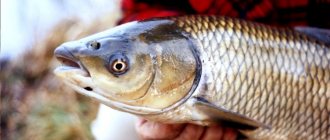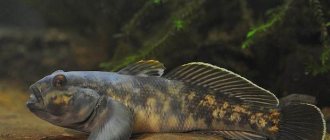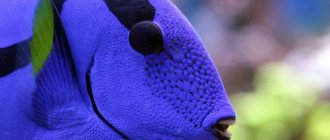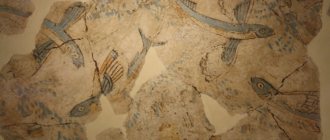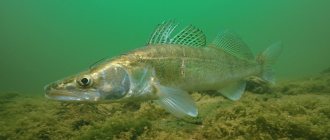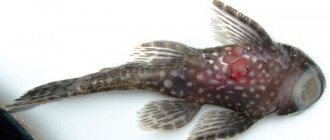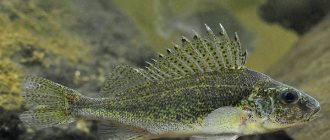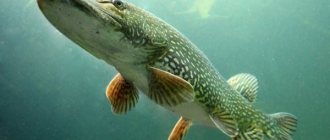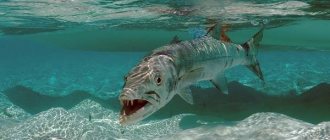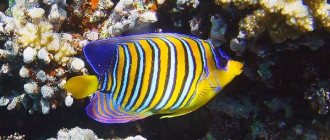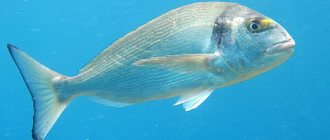Origin of the species and description
Photo: Sterlet
The history of the species dates back to the end of the Silurian period - about 395 million years ago. It was during this period that an important evolutionary change occurred in prehistoric fish-like fish: the transformation of the anterior gill arches in the jaws. First, the gill arch, which has a ring shape, acquired an articular joint that helps it fold into a double half ring. The result was some semblance of a grasping claw. The next stage is connecting the skull with the upper half-ring. The other of them (the future lower jaw) retained mobility.
As a result of the changes that occurred with fish, they turned into real predators, their diet became more varied. While the ancestors of sterlets and other sturgeons only filtered plankton. The appearance of sterlets, the one with which they have survived to this day, was formed 90-145 million years ago. We can say that these fish are contemporaries of dinosaurs. Only, unlike prehistoric reptiles, they safely survived a number of global catastrophes and reached the present day practically unchanged.
This indicates the ecological plasticity of fish, the ability to adapt to environmental conditions and use the resources allocated by nature to the maximum. The heyday of sterlet and other sturgeon dates back to the Mesozoic era. Then some of them were replaced by bony fish. However, unlike armored species, sturgeons survived quite successfully.
Lures for sterlet
Sterlet is not lured; baits of animal origin are used. The most popular are medium-sized worms and small shrimp. Maggot is often used as an addition to any worms - dung, rain and crawling.
Also suitable as bait:
- small butterflies;
- beetle larvae;
- bloodworm;
- fry of other fish.
The size of the sterlet bait should not exceed 5 cm; a cautious prey will simply bypass a large bait.
Appearance and features
Photo: Sterlet fish
The sterlet belongs to the subclass of cartilaginous fish. The appearance of the scales resembles bone plates. The spindle-shaped elongated body is completely covered with them. The characteristic feature of sturgeon fish is the cartilaginous notochord, which forms the basis of the skeleton. Even adult fish have no vertebrae. The skeleton and skull of sterlets are cartilaginous; there are 5 lines of bone spines on the body.
The mouth is retractable, fleshy, teeth are missing. Below the spine is the swim bladder, connected to the esophagus. Sterlets and other sturgeons have squirts - openings that extend from the gill cavities to the covers. The great white shark has something similar. The number of main gills is 4. Gill rays are absent.
The sterlet has an elongated body and a relatively large triangular head. The snout is elongated, conical in shape, the lower lip is forked. These are the distinctive features of fish. At the bottom of the snout there are fringe whiskers, which are also found in other sturgeon species. There are 2 varieties of sterlets: sharp-snouted (classic version) and blunt-snouted, with a slightly rounded nose. As a rule, blunt-snouted individuals include individuals that are not capable of reproducing, as well as domesticated ones that are bred artificially. The eyes of sterlets are small and protruding.
On the surface of the sterlet's head there are bony scutes fused together. The body is covered with ganoid (containing an enamel-like substance) scales with comb-like projections that resemble grains in appearance. A feature that distinguishes sterlets from most other fish is the dorsal fin shifted towards the tail. The shape of the tail is typical for sturgeon: the upper blade is longer than the lower one. As a rule, sterlets are gray-brown in color, sometimes with light yellow areas. The lower part is lighter than the back; in some individuals the abdomen is almost white.
Of all sturgeon fish, the sterlet is the smallest. The length of adult individuals is rarely more than 1.2-1.3 m. Most cartilaginous animals are even smaller - 0.3-0.4 m. Sterlets have no sexual dimorphism. Males and females are completely identical in color and size. The type of scales they have is also practically the same.
Range, habitats
Sterlet fish is found in rivers flowing into the Azov, Black and Caspian seas, as well as in more northern regions through which rivers such as the Ob, Yenisei, and Northern Dvina flow. In addition, sterlet is also found in the basins of lakes such as Ladoga and Onega. It was also artificially introduced into such reservoirs as the Neman River, Pechora River and Oka River, including some large reservoirs.
How to clean sterlet
Many people wonder: how to clean sterlet? If the fish is alive, it should be placed in the freezer for 1 hour.
You need to cut the sterlet with a sharp knife as follows:
- rinse the fish and pour boiling water over it to get rid of mucus;
- cut off all the bugs on the back, working from the tail to the head;
- scrape off the skin between the scutes;
- cut off the tail and fins. When cooking whole, the gills should be removed.
Cut the belly lengthwise down the center and remove the insides. Proceed carefully, without touching the gallbladder. If you come across caviar, it must be washed well, freed from the film and salted.
To remove the vizier: make one transverse cut near the head, and the second near the tail, cutting the ridge of the fish. Pick up the white cord with tweezers or a hook and carefully pull it out without damaging the walls of the vizig (it is poisonous inside). If it is not removed, the meat will become hazardous to health.
Structure
Sterlet, like other sturgeons, is a cartilaginous-boned fish whose scales grow together and form bony growths covering the head and entire body. The narrow, streamlined body ends in a strong tail with a long upper ray.
Sterlet, like other sturgeon fish, does not have a bony spine. Instead, there is a notochord - cartilage, which forms the basis of the fish skeleton. In both young and adult fish, the skeleton and skull are made of cartilage. The swim bladder is large, located in the lower part of the spine, and has a connection to the esophagus. The sterlet has four main and two accessory gills; there are no gill rays. There is a hole (spray) leading from the gill cavity to the upper edge of its cover.
Body
The sterlet has a long, elongated, triangular body, resembling a spindle in shape. The sterlet does not have scales in the usual sense of the word. The body has five longitudinal lines of bone scutes - bugs:
- dorsal,
- two side ones,
- two abdominal.
Sturgeon bugs (emphasis on U) are diamond-shaped bony plates of fused modified ganoid scales containing an enamel-like substance. They look like ridge-like projections in the form of grains. The bugs perform a protective function. There are usually 12-11 dorsal bugs, 10-20 ventral bugs. At the base of the pelvic fin is the anus.
Head
The head is quite small in proportion to the body. The sterlet's snout is elongated, slightly flattened from top to bottom, and resembles a cone in shape. The lower lip is divided into two parts, which serves as one of the distinguishing features of the sterlet from other sturgeon fish.
On the lower part of the snout there are four small antennae resembling a fringe. They serve as a tactile organ, allowing them to move and feed in conditions of poor visibility. In muddy water, a sterlet can feel the bottom with its antennae and look for food. Other sturgeon species also have these antennae. The top of the head is covered with fused bone scutes, which serve as reliable protection. The eyes are small and protruding.
Mouth
The mouth is small, located on the underside of the snout after the antennae. The sterlet's mouth is fleshy and does not have hard protective plates. When grabbing food, it can move forward. The sterlet has no teeth.
Fins
The fins of the sterlet are hard. The dorsal fin is located towards the very tail of the fish and has from 30 to 50 rays. The pectoral fin contains a spine, which can be used to determine the age of the caught fish. The anal fin is well defined, it usually has 15-35 rays. The caudal fin is divided into two lobes, the upper one being much longer and larger than the lower one. This tail shape is characteristic of all sturgeons.
Body coloring
The sterlet has a dark gray-brown color on the back and sides. The color of the sterlet’s body depends on the specific habitat and varies from brown to dark sand and gray; in the light it can turn dark green. The belly is light gray, sometimes almost white.
Sexual dimorphism
Sterlet has no sexual dimorphism. This means that female and male individuals do not differ at all from each other in appearance: neither in size, nor in shape, nor in color. This phenomenon is quite rare in the animal world.
Offspring
The eggs are dark green-brown, sometimes black, 2-3 mm in diameter.
They have a slightly elongated oblong shape. After 6-10 days after the incubation period, larvae emerge and feed on the contents of the yolk sac. After 7-10 days, the reserves of the yolk sac dry up, the larva becomes a fry and begins to look for food on its own. By this age, the fry reach a length of only 1.5 centimeters. The fry are a little reminiscent of adult fish in appearance, but are still different from them. The head and body of the fry are covered with a large number of small, sharp, thorny spines. The body color is darker than that of adult fish; the upper half of the body, the blade of the caudal fin, has a particularly dark shade. The fry have teeth, but gradually they wear down and disappear.
You may be interested in: Boat Trailers: 20 Best Boat Trailers
The fry remain all summer in the place where they emerged from the eggs. Gradually they gather in flocks. They feed on zooplankton and zoobenthos. The fry grow quite quickly in the first year and by the beginning of autumn they grow to 15-20 centimeters in length, turning into young sterlets. With the arrival of autumn, they rush back to the mouths of rivers, to more mature representatives of the species.
By the end of the second year of life, young fish reach 25-30 centimeters in length.
Character and lifestyle
Sterlet is a predatory fish species. She prefers to live only in rivers with clean and clear water, in flowing conditions. It can swim into the seas, but at the same time stays closer to the mouths of rivers.
In summer, the fish prefers to stay in shallow areas of the river, and young individuals are found in narrow channels or bays, near the mouths. With the onset of cold weather, the fish go to wintering pits, where they wait for the arrival of spring. During the cold period, the sterlet practically does not move and does not feed on anything. After the ice melts, the fish leave their wintering pits and rise up the river to continue their race.
Interesting to know! Unlike other representatives of sturgeon fish species, which prefer to lead an isolated lifestyle, the sterlet prefers to stay in numerous schools. She even spends the winter surrounded by numerous of her relatives.
Several hundred sterlets can overwinter at the bottom of the pit, pressing quite tightly against each other. This, to some extent, prevents them from moving their fins and gills.
Summer fishing
To catch sterlet in the summer, use regular float rods or a donk. You can use a float rod to fish in shallow water, especially in the evening, when fish rise from deep holes to feed.
You can catch sterlet on a donka during the day by finding holes where the fish are located; usually they are caught this way in the fall. You can use a feeder with equipped hooks. You can catch sterlet using a spinning rod, but you must take into account the strength of the water current and the weight of the sinker. The license allows up to 5 hooks.
You can fish after spawning, i.e. at the end of May - beginning of June. Fishing will be especially successful from June to early August. At this time, it is best to catch sterlet late in the evening or early in the morning.
For bait they use worms, small crustaceans, jigs, and amphipods. When fishing, it is necessary to maintain silence; the sterlet is afraid of extraneous sounds.
Types of sterlet
Officially, one subspecies is distinguished: the Siberian sterlet. It lives in the basins of the Ob and Yenisei rivers. The morphological characteristics that distinguish this variety of sterlet include a darker body shade and a larger number of gill rakers. Due to climatic conditions, sterlet living in Siberia has fattier meat.
In various sources, names of populations very often appear according to the place of their distribution: Volga, Don, Sukhoya populations.
Hybrid forms of the species include:
- Bester is a hybrid of sterlet and beluga. Bester adapts well to living conditions and is characterized by high rates of growth and weight gain when fed with mixed feed.
- Koster is a cross between sterlet and Siberian sturgeon.
- The thorn sturgeon is a hybrid of sterlet and Russian sturgeon.
- Stellate sturgeon is a hybrid form obtained by crossing sterlet and stellate sturgeon.
Sterlet habitats
Sterlet is predominantly a river fish and is less common in deep lakes. The main habitats of the sterlet are in the fresh waters of European Russia, including Siberia and tributaries of the Yenisei. Fish are numerous in the Kama, on the Catherine Canal, in the Northern Dvina basin. The Volga basins (in its lower and middle reaches) are famous for a large number of sterlet; they are also found in Lakes Onega and Lake Ladoga.
Avoids salty water, preferring to live in river basins of the following seas:
- White;
- Barentsev;
- Karsky;
- Caspian;
- Azovsky.
In the Dnieper basins, a valuable specimen is found in the Smolensk and Bryansk regions, swimming in the clear waters of the Danube, Prut and Bug. In the Black Sea basin, sterlet appears rarely and in small schools; every year there are fewer and fewer fish there, which signals pollution of water bodies.
What is the difference between sterlet and sturgeon
The general external characteristics of most sturgeons are quite similar, however, there are several signs that allow you to accurately determine the type of fish. The main difference between sterlet and sturgeon is the size and weight of adults. Sturgeon can grow up to 1.5 m or more with a weight of 15-20 kg, while the average length of a sterlet is between 40-60 cm and a weight of 1-3 kg.
You can distinguish juvenile sturgeon from adult sterlet by the following features:
| What to pay attention to | Sterlet | Sturgeon |
| Head | The nose is elongated and pointed, the antennae located near the mouth have a fringe. | The nose is moderately elongated, rounded, the antennae are devoid of fringe. |
| Bone growths | The scutes have spines, their number in the lateral rows reaches 70, with the growths touching each other. | The scutes are without spines; there are from 36 to 56 growths on the sides. |
| Body Shape | The body is elongated, thinner. | The body resembles a spindle, the middle part is thicker. |
When comparing the taste of two types of fish, sterlet will be more tender and juicy, since the amount of fat in it is almost twice as much as in sturgeon.
What does a sterlet fish look like?
According to its external description, sterlet is similar to other sturgeons:
- the body of the fish is elongated and has a spindle-shaped shape;
- the basis of the skeleton is the cartilaginous chord;
- along the body there are rows of bone growths with comb-like protrusions;
- the relatively large head has a triangular shape with an elongated snout flattened on top, near the mouth there are 4 fringed antennae;
- between the eye and the gill cover there is a small hole - the squirter;
- the caudal fin consists of two blades, the upper one being longer.
Sterlets have a gray-brown tint with lighter areas reaching yellow. The back of the fish is dark, closer to the belly the shade becomes lighter. The intensity of color largely depends on living conditions. There is no noticeable external difference between males and females.
Dimensions and weight
The growth rate of sterlet is slightly higher than that of other members of the family. During the first year of life, juveniles grow to sizes of 15-20 cm. By the end of the second year, individuals reach 25-28 cm. Further, if there is a sufficient food supply, the annual increase in length is within 4-5 cm.
The average weight that a sterlet reaches before puberty is 1 kg, while the size of an adult is in the range of 50-60 cm. The fish can reach 5-6 kg, but it is very rare to find such a specimen.
The officially recorded maximum size of a sterlet is 1 m. The fish was caught in the Volga in 1849. The largest sterlet weighed 20 kg.
How many years does a sterlet live?
Under natural conditions, in the absence of fishing, the life expectancy of fish reaches 22-23 years. When artificially reared, sterlet is caught at the age of 3-4 years, since after this the growth rate decreases
When does the sterlet spawn?
Puberty in males occurs at 3-4 years of age, in females - one or two years later. Most of the adult individuals reproduce not in every spawning season, but every other year. The beginning of spawning, depending on the region, occurs in April-May; the main condition is the water warming up to +8-10 degrees. The sterlet does not go to spawn as a whole flock; first, the males rise up the river bed, they look for suitable areas, and then, when the water warms up to +12-13 degrees, the females join them.
Spawning occurs at a depth of 8-15 meters. The female lays eggs, which after fertilization sink to the bottom and stick to pebbles and stones. After the end of spawning, the sterlet returns to its usual habitats and begins to actively feed, restoring its weight.
The larvae emerge from the eggs on days 6-9. In the first few days after hatching, their life is supported by nutrients from the yolk sac, and when the formation of the connection between the mouth and stomach ends, the sterlet fry switch to external nutrition.
Sterlet breeding
Sterlet reaches sexual maturity earlier than other sturgeon fish: males at 4-5 years of life, females at 7-8. Female sterlets do not spawn every year; they usually spawn every other year; in northern regions and under unfavorable living conditions, females spawn after two to three years. This mechanism of biological restoration of females for the next spawning sometimes works in a negative direction: females during this period of “spawning rest” of two to three years manage to gain too much fat and lose the ability to reproduce.
Spawning begins at different times in different regions depending on water and air temperatures. Warming up the water to optimal values of 10-15ºС starts the spawning process. Most often, mass spawning of sterlet begins in the second half of May, sometimes moving into early summer in late spring. In more southern regions, spawning begins in April.
In addition to water temperature, spawning is affected by the water level in rivers: the higher the level, the earlier spawning occurs. Fish that live in the upper reaches of rivers spawn earlier than those that live in the lower reaches.
For spawning, sterlet strives to find deep-water (up to 7-10 meters) sections of rivers with fast currents, clean water and hard soil: pebbles, driftwood, stones. Most often they rush to the upper reaches of rivers and small river channels and streams.
The older the female, the more eggs she lays. Young females lay 15-20 thousand eggs, adults over 13-15 years old lay 50-60 thousand eggs, females over 30 years old are capable of laying up to 140-150 thousand eggs.
Caviar has an adhesive surface, sticks well to small stones at the bottom of the river and is not washed away by the current. The males fertilize her, and the sterlet returns to its usual habitats. Spawning is complete.
What does the sterlet eat?
For active development, sterlet needs a large amount of protein, therefore it prefers animal food. The predator can search for prey both on the surface and near the very bottom. The diet of an individual varies depending on age and size. Thus, the fry eat zooplankton, daphnia, artemia and other small crustaceans, larvae, and mollusks. Juveniles hunt mosquitoes, midges, caddis flies, bloodworm larvae, and eat fish eggs, including those laid by females of their species. The most mature individuals prefer worms, leeches, mollusks, fry and small fish.
While searching for food at the bottom, the sterlet detects the movement of prey with its antennae located near its mouth. During the season of mass emergence of insects, sterlet moves to the very surface. She eats midges that have fallen into the water or jumps out of the water, becoming almost vertical and grabbing butterflies, beetles and grasshoppers in flight.
The nutrition of sterlet directly affects the growth rate and size of individuals.
Kinds
Yes, such fish, according to rumors, some time ago were much larger than they are now. In addition, sterlets look very unusual. But this is not why our ancestors called them “royal”. But because this fish has always been considered an elite delicacy, served only in palaces, and not every day, but only on holidays.
Its catching has always been limited, and even the fishermen themselves did not dream of trying at least a piece of their catch. This delicacy was valued along with sturgeon. But what is the difference between two such fish, each of which since ancient times belonged to the category of noble ones? Actually, both of them belong to a fairly large sturgeon family, which in turn is divided into five subfamilies.
Both of our fish are classified by ichthyologists as belonging to one of them and to a common genus called “sturgeon.” Sterlet is only a variety of this genus, and its relatives, according to the accepted classification, are considered to be stellate sturgeon, beluga, thorn and other well-known fish.
This is a very ancient species, inhabiting the underwater world of the planet for many millennia. This circumstance, in addition to archaeological finds, is indicated by many external and internal archaic signs of its representatives.
In particular, such creatures do not have a bony spine, but instead have only a cartilaginous chord that performs supporting functions. They also have no bones, and the skeleton is built from cartilage tissue. Most sturgeon have always been famous for their enormous size.
Special giants with a six-dimensional length can weigh up to 100 kg. However, sterlet from its family belongs to small varieties. The nose of sturgeons is shorter and the head is wider than that of members of the species we are describing. These underwater inhabitants also differ in the number of bone scutes on their sides.
As for the sterlet, two forms are known. And their main difference is in the structure of the nose. As already mentioned, it can be somewhat rounded or classic long. Depending on this, our fish is called: blunt-nosed or sharp-nosed. Both types differ not only in appearance, but also in habits.
Instances of the latter are prone to movements, which they are forced to do by weather conditions and even changes in the time of day, as well as the presence of unpleasant factors, that is, noise and other inconveniences.
The blunt-nosed one, on the contrary, prefers to hide from the troubles of the world at the bottom of reservoirs. She is careful, and therefore fishermen have little chance of catching her. True, poacher’s nets can become a trap, but this type of fishing is considered unacceptable by law.
Natural enemies of sterlet
Photo: What a sterlet looks like
Since the sterlet prefers to stay closer to the bottom of the reservoir, it does not have many enemies. And even those threaten not adults, but fry and eggs. For example, beluga and catfish are not averse to eating sterlet caviar. More effective predators that massively destroy fry and teenage sterlets are pike perch, burbot and pike.
In unfavorable living conditions, fish often get sick.
The most common diseases:
- gill necrosis;
- gas bubble disease;
- saprolegniosis;
- myopathy.
Sterlet lifestyle
Sterlet fish is found in clean, deep-water rivers with a sandy, pebble or rocky bottom. Small rivers with muddy bottoms, mud and stagnant water are avoided. Salted water is also avoided. The fish is a semi-anadromous species, but is not suitable for long swims; it stays near the very bottom, coming to the surface only during the spawning period or for prey.
The sterlet’s lifestyle is collective; the fish gather in small schools according to age and rarely move alone. The winter season for sterlet ends as soon as the river loses its ice. The start time of spring activity depends on the region - from mid-March to April. Before spawning, the fish feeds heavily, and after spawning it comes closer to the surface to regain strength. In summer, sterlet spends the day in the depths, and in the evenings it swims to areas of the coast where there is a lot of vegetation. The sharp-nosed sterlet is more active than the blunt-nosed sterlet, which prefers depth.
The sterlet spends the night off the coast, catching insects. She has the ability to roll over onto her back and grab food falling from the branches with her mouth. With the onset of autumn, the fish goes to the bottom, looking for the deepest and warmest areas, where it buries itself in the sand or hides under stones. She spends her winter time in this position. It prefers holes at a depth of 20-25 m, where it is packed in dense rows. Sterlet hibernation begins early - already at the end of September the fish loses activity and lies down, spending the winter without food.
Population and species status
Photo: Sterlet in the wild
Just a few decades ago, sterlet was considered a completely prosperous and numerous species. However, unfavorable environmental conditions, pollution of rivers by runoff, as well as uncontrolled fishing have led to a sharp decline in the number of the species. Therefore, this fish has received the status of a vulnerable species according to the international classification. In addition, the sterlet is listed in the Red Book as an endangered species.
Until the middle of the last century, active fishing for these fish was carried out. Currently, sterlet fishing is strictly limited. However, fish often appears on sale in smoked, salted, canned, fresh or frozen form. The reason for this is that sterlets are actively bred in captivity, on specially equipped farms. Initially, these measures were taken to preserve the biospecies. Then, with the increase in the number of fish in captivity, the revival of the traditions of ancient Russian cooking began.
There are several ways to grow sterlets in cage farms:
- Introducing adult fish into cages.
- Raising fry. At first, young animals are fed crustaceans, and as they grow older, they diversify their diet with minced fish and mixed feed.
- Incubation of eggs - keeping them in special conditions, which leads to the appearance of fry.
Of course, sterlets raised on farms are inferior in taste to fish raised in the natural environment. And their cost is quite high. However, the development of fish farms is a good chance not only for the survival of sterlet as a biospecies, but also for returning its commercial status. Unpretentiousness to food makes it possible to successfully grow fish in artificial conditions. Breeding new species of sturgeon, such as bester, is also beneficial.
The peculiarity of the hybrid is that it combines the advantages of both “parental” species: rapid growth and weight gain - from beluga, early maturation, like sterlets. This makes it possible to quickly reproduce offspring in farm conditions. The most difficult problem is training fish to feed. If you create favorable conditions for them, then in 9-10 months you can grow a five-gram fry into a marketable specimen, the net weight of which is 0.4-0.5 kg.
Nutrition
The elongated nose that nature gave the sterlet was given to it for a reason. This appendage once existed to search for prey, which the ancestors of modern individuals found by rummaging in the muddy bottom. But over time, the habits of the fish changed, all because the external conditions and the habitat of these creatures changed.
And the search function was taken over by fringe-like antennae, which were already mentioned in the description earlier. They are located in the anterior region of the snout and are endowed with such remarkable sensitivity that they enable their owners to feel how their small prey is swarming in the river bottom.
And this is even though the fish moves quickly in the water. Therefore, now the nose for the pointed-nosed representatives of the species has turned into a useless decorative element, a souvenir of evolution. But the blunt-nosed specimens, apparently, have undergone external changes over the centuries.
All representatives of the species we are describing are predators, but they feed differently, and they are not particularly picky about food. Large individuals can eat other, mainly small fish, although hunting and attacks on their own kind are rare for such creatures.
And therefore their diet mostly consists of leeches, bugs and mollusks. And the smaller ones eat the larvae of a variety of insects: caddis flies, mosquitoes and others. The menus of the male and female halves also differ during the breeding season.
The thing is that females and males live in different waters. The first ones stick to the bottom and therefore eat worms and other small living creatures that live in the silt. And the latter swim high, which is why they catch invertebrates in fast water. Often such fish find food in shallow water in grass thickets and reeds.
Reproduction process
Females reach sexual maturity at the age of 7.5 years, and males at 4.5 years of age. Moreover, sterlet does not reproduce annually, but every other year.
This allows females to fully recover from the spawning process, since it takes a lot of strength and energy from the fish.
Sterlet spawns in late spring and early summer. To do this, you need the water to warm up to +8-+ 20 degrees, although the optimal threshold for these species is about +12.5 degrees. There are cases when fish spawning begins earlier or later than certain dates due to weather conditions. In addition, the level of spring waters also affects the beginning of the spawning process.
The Volga sterlet is different in that it does not spawn at the same time. As a rule, individuals that live in the upper reaches of the river spawn somewhat earlier than those individuals that inhabit the lower reaches of the river. This is due to the fact that the spring flood occurs earlier in the upper reaches of the Volga and then gradually spreads to its lower reaches. For spawning, the fish chooses areas of the reservoir where the current is fast and the water is crystal clear. In this case, the bottom of the reservoir should be hard, covered with pebbles. The sterlet fish is quite prolific, since the female can lay more than 15 thousand eggs at a time.
Sterlet lays fairly sticky eggs, which develop on the bottom for several days, after which sterlet fry emerge from the eggs. At the same time, they remain in the yolk sac for up to ten days. When the yolk sac disappears, the size of the individuals reaches no more than 1.5 cm in length. Sterlet fry bear little resemblance to adults. Their mouth is very small with a cross-section, and their antennae, in the form of a fringe, are almost the same size. As for the lower lip, it can already be divided into 2 parts, as in adult representatives of this species. The top of the head is covered with numerous small spines, and the color of the fry is somewhat darker than the adults. This is especially noticeable closer to the tail of the fry.
After birth, the fry remain in these places for a long time and only with the arrival of autumn, when the fry reaches a size of about 20 cm, do they roll downstream. Representatives of different sexes grow at the same rate, while they are practically no different from each other. The coloring also doesn't indicate much.
Interesting to know! Sterlet often crosses with other representatives of this family. In soybeans, by crossing beluga and sterlet, it was possible to obtain a rather valuable hybrid - bester. Since the 50s of the last century, this hybrid is still considered an object of industrial interest.
The hybrid differs in that it contains the main advantages of both types. Bester gains weight and grows well and quickly, which is typical for beluga. In addition, individuals of the hybrid mature much faster in terms of laying eggs, which makes it possible to carry out the process of reproduction of the species much faster, especially in captivity.
Reproduction and lifespan
Sterlet fish live a long time, about 30 years. It is assumed that among this species there are also long-livers, reaching an age of 80 years. But the veracity of such a hypothesis is difficult to verify. Representatives of the male half become mature for reproduction at 5 years of age, but females are fully formed on average two years later.
Spawning usually occurs in places where shore stones accumulate in the upper reaches and begins at a time when, after the snow has melted, the water is still high and hides the fish from unwanted witnesses; more precisely, this happens somewhere in May. The eggs swept out are smaller in size than sturgeon eggs, have a sticky structure and a yellowish or gray tint, very similar in color to the body of the fish themselves.
Their number at a time amounts to thousands, ranging from 4,000 to a record number of 140,000 pieces. At the end of the spawn, which is produced in small portions and lasts two weeks, after another seven days the fry appear. At first, they don’t even dream of long journeys, but live in the places where they were born.
They don't require food. And they take the substances necessary for existence and growth from their own internal reserves in the form of gall bladder juices. And only having matured slightly, they begin to explore the surrounding aquatic environment in search of food.
Sterlet protection
Photo: Sterlet
The problem of reducing sterlet populations is mainly associated not with climate change, but with anthropogenic activities.
- Discharge of wastewater into water bodies. Sterlets cannot live in polluted, non-oxygenated water. The discharge of chemical compounds and industrial waste into rivers negatively affects the number of fish.
- Construction of hydroelectric power stations on large rivers. For example, after the creation of the Volzhskaya hydroelectric power station, about 90% of the spawning grounds were destroyed because the fish were not able to overcome artificial concrete obstacles. Excess food for fish located in the upper reaches of the Volga has led to obesity and impaired reproductive function of sterlets. And in the lower sections of the river, eggs died from lack of oxygen.
- Unauthorized fishing. Catching sterlets with nets has led to a decrease in their numbers.
In Russia there is a state program aimed at preserving the species. One of the successful measures is the reacclimatization of fish in reservoirs. The rules for catching sturgeon are strictly regulated. Obtaining a special license gives the right to catch a certain number of adult fish. The permitted type of gear is hooks (5 pieces) or, as an option, 2-piece nets. The permissible number of fish caught under a one-time license is 10 pieces, and under a monthly license - 100 pieces.
The weight and size of fish are also regulated:
- Length - from 300 mm.
- Weight - from 250 g.
The period when fishing is allowed is from July to September. The number of licenses is limited, so those interested must take care of obtaining them in advance.
Fortunately, sterlets are an ecologically flexible species. To restore the numbers of this fish, all that is needed is the creation of favorable living conditions, protection of spawning grounds and restrictions on fishing. A positive point is the hybridization of sturgeon, which allows one to obtain viable, stable forms. The sterlet to be saved . The extinction of a biological species inevitably leads to disruption of the ecological system, which negatively affects people, among other things.
Where is the sterlet found?
The natural habitat of the species in Russia is quite extensive. Self-sustaining populations of sterlet can be found in rivers connecting to the Azov, Black, Caspian, Baltic seas, as well as in Siberia. Many attempts have been made to spread the species throughout Europe and Asia, but most of them do not have evidence of successful adaptation. Currently, the largest population lives in the Volga, Yenisei and Ob.
Due to the decrease in the number of the species in natural conditions and strict restrictions on catch in recent decades, artificial cultivation of sterlet has become increasingly popular. For fish farming, natural reservoirs and specially adapted pools with the ability to purify water and enrich it with oxygen are used.
How much sterlet grows in a year depends on the purity of the water, its temperature and a sufficient amount of food. Typically, fish grown in artificial conditions reach marketable sizes much faster than individuals living in nature.
The nutritional value
Sterlet fish is distinguished by a pleasant sweetish taste, complete absence of bonyness and culinary versatility, which allows the use of many different cooking techniques. Fish is used to make fish soup, balyk, aspic, shish kebab, grilled fish, pie filling, and solyanka. Sterlet meat lends itself well to salting, smoking, boiling, baking, frying, and steaming. Caviar, which is often dark gray in color, but can also be a rich black hue, is famous for its excellent gastronomic qualities.
The average calorie content of sterlet is 88-90 kcal per 100 g, which allows it to be classified as a dietary product. Regular consumption of fish helps normalize metabolism, prevent vascular diseases, reduce the risk of atherosclerosis and improve mood due to the significant inclusion of serotonin. Sterlet also contains a number of other substances beneficial to the body:
vitamins of group B, PP, D, E, A; fluorine, chromium, zinc; sulfur, molybdenum, nickel; calcium, iodine, selenium; polyunsaturated fatty acids (Omega-3 and Omega-6); easily digestible proteins.
How to cook sterlet: features and video recipes
Sterlet is considered a universal fish. It can be prepared in any form - boiled, fried, stewed or baked.
How to bake a whole sterlet in the oven - video recipe:
The taste of fish is perfectly revealed when cooked on the grill. It is also permissible to salt or smoke sterlet. Its meat can be used as a filling for pies. One of the most popular dishes is the royal fish soup.
Royal sterlet fish soup:
Sterlet is considered a common fish that contains many valuable components and has a wonderful taste.
Sterlet in the oven in foil - step-by-step video recipe:
To get tasty and healthy dishes from it, it is important to follow the technology of their preparation.
Sterlet diseases
Sterlet is quite susceptible to various diseases, so it prefers the cleanest possible water, where the risk of contracting the disease and becoming infected with parasites is minimal. Unfavorable living conditions and lack of food weaken the immune defense of fish, which also leads to an increase in the number of possible fish diseases.
The most common diseases of sterlet:
- saprolegniosis,
- myopathy,
- gill necrosis,
- gas bubble disease.
The high susceptibility of sterlet to diseases creates additional troubles during artificial fish breeding, forcing more careful monitoring of the cleanliness of the reservoir and other conditions of its existence.
Security
Since there are several reasons for the decline in sterlet numbers, several areas of action have been developed aimed at preserving and increasing sterlet populations:
- ban on fishing for sterlet. Sterlet cannot be caught in its natural habitat. The exception is special fish farms and farms where sterlet is bred artificially. To catch sterlet in such reservoirs, you must obtain permission.
- Restoring the ecological purity of reservoirs and environmental zones. It is necessary to monitor the treatment of wastewater from enterprises, since contaminated water has a detrimental effect on fish.
- Breeding sterlet in artificial conditions.
- Raising fry in fish farms and then releasing them into the natural environment.
- Hybridization of the species. Sturgeon hybridization is being carried out. Crossing different species allows the emergence of new, more viable species.
Sterlet in cooking
Since it is prohibited to catch sterlet in ordinary reservoirs, it is bred for commercial purposes in special reservoirs and on fish farms. You can get permission to fish in such a reservoir and catch delicious fish for your table yourself. The fish that is sold in stores and fish markets is also grown in artificial conditions.
Sterlet has a number of features that you need to know before cooking it.
There are no bones in it; instead of the usual spine, a long thin cartilage runs along the entire body, called the viziga. It is a dense, tight cord of bubble tissue, which is covered with connective tissue with cartilage. Viziga can be poisonous in some fish. The sterlet vizig is not poisonous; if you eat it, a person will not be poisoned.
Previously, in Rus', viziga was added as a filling to pies, it was braided and baked, and it was consumed as a delicacy. It contains a large amount of vitamins and nutrients. But now it is not eaten as it may contain parasites. When cooking fish, it is always removed.
This is done for two reasons. First: if the vizig is not removed, during the heat treatment the fish will curl up and lose its beautiful appearance. The second reason: the viziga in fresh fish begins to deteriorate first, and this can quickly spoil the entire fish. To avoid this in the fishing industry, when cutting fish, the visigu is immediately removed, after which the fish can be stored much longer.
Externally, the sterlet has no scales. It is covered in mucus and has several rows of bone spines that must be removed. Sterlet has no bones, so you can cook almost anything from it: fish soup, aspic, grill, pies, soup, solyanka, shish kebab. Sterlet can be salted, dried, fried, baked, boiled, smoked. When eating sterlet there is no danger of choking or being injured by sharp bones.
How to clean fresh sterlet
- First, mucus is removed from its surface. This can be done with a napkin, or rub the fish with salt and rinse with water; the salt will pull away the mucus.
- Then you need to cut off the bone spines on the back, sides and abdomen. You need to cut it with a sharp knife, carefully so as not to get hurt, as the thorns are very sharp.
- If the head is not needed, it must be removed. If you plan to cook the head, it is necessary to remove the gills, eyes and remaining entrails, as they give off bitterness when cooked.
- Then you need to remove the insides. They are removed carefully, especially the gallbladder, trying not to damage it, since if the contents get on the meat, it will spoil its taste. Remove the internal films and wash the fish carcass from the inside.
- Then the vizig is removed. To do this, you need to make two cuts: near the head and at the beginning of the tail. Carefully grab the screed (you can use pliers) and pull it out.
How to clean frozen sterlet
Frozen sterlet is cleaned in the same way as fresh. First you need to defrost the fish. In principle, cutting frozen fish is even easier than fresh fish. Once defrosted, fish should not be re-frozen as it will lose its shape and consistency and become jelly-like. It definitely needs to be prepared.
- Bone spines are easier to remove, but they are also more likely to damage the skin.
- Next, the head is removed.
- Clean out the insides.
- Remove the vizig. To do this, the fish must be completely defrosted, otherwise you will not be able to remove the cartilage.
To prevent pieces of defrosted sterlet from losing their shape during cooking and forming protein clots, the fish pieces must be doused with boiling water before cooking. This will instantly denature the surface protein and prevent the protein from inside the piece from bleeding through.
Sterlet soup
First, the fish must be washed, cleaned, gills and entrails removed, and rinsed thoroughly. Place the fish in a pan, add a peeled whole onion, peeled diced potatoes, and cover with cold water. Boil. Add finely chopped herbs, parsley root, celery root, bay leaf. Cook over low heat for 50-60 minutes. Then let it brew for 20-30 minutes. Can be served with black bread or croutons.
Royal sterlet
The dish is worthy to decorate any holiday table.
It is necessary to wash, clean, gut the fish, remove the gills and vizig, and make an incision around the head. Pour boiling water over the fish, rinse under cold water, rub with pepper and salt. Place the fish in a baking dish, add a little white wine, lemon juice, peppercorns, and add vegetable oil. Bake in the oven at 140-150 degrees for 40-50 minutes. When the fish is cooked, cool it. Grasp the skin at the incisions near the head and remove it. Next, prepare the sauce: pour white wine into a ladle, add cream, add a little salt and pepper. Bring to a boil and turn off, add finely chopped herbs.
Place the fish in a beautiful dish and pour the sauce on top. You can decorate with lemon, herbs, tomato and cucumber slices.
Baked sterlet
Wash the sterlet, clean it, remove the vizig and bone spines, gut it, cut off the fins and tail. Rub with salt and pepper, put in the refrigerator for 10-20 minutes to soak. After this, cut the lemon into slices. Make small cuts on the fish and insert a slice of lemon into each cut. Sprinkle with basil. Place the fish on foil or in a baking bag. Place in a preheated oven, bake for 25-30 minutes at 180 degrees. Then open the foil a little or make a small cut on the bag and bake for another 15 minutes.
Catching sterlet
This type of fish has long been included in the pages of the Red Book and has firmly taken root there. Therefore, fishing for sterlet is for the most part prohibited, and in some regions it is limited by strict rules. A license is required for this type of fishing.
At the same time, it is allowed to catch only adult large fish in quantities of no more than ten. And only out of sporting interest, and after that the prey should be released. But breaking the law is not uncommon, as is the use of poaching gear.
Such arbitrariness becomes a terrible blow and causes significant damage to the already small population of sterlets. Significant restrictions are imposed on its commercial production. And the fish that ends up in stores and is served to lovers of “royal” food in restaurants is most often not caught in natural conditions, but grown in special farms.
Some time ago, at the initiative of biologists, special operations were carried out in the Amur, Neman, and Oka. The breeding of the endangered species was carried out using an artificial method, that is, by placing sterlet fry raised in a different environment in the waters of the indicated rivers.
Economic importance of sterlet
Previously it was a common commercial fish. In 1889-1913. An average of 38 tons of sterlet were caught per year in 1946-1950. - up to 30 tons. Currently, sterlet is a valuable object of fishing and fish farming. They are caught with floating nets, seines, and special traps. Object of pond, lake management and acclimatization in reservoirs. Sold fresh, chilled, frozen, salted or smoked. It is also used for making canned food (in tomato sauce, less often in its natural form). Meat fat content is 5.6-6.4%.
The species is included in the IUCN Red List of Red Lists.
Literature: 1. Lebedev V.D., Spanovskaya V.D., Savvaitova K.A., Sokolov L.I., Tsepkin E.A. Pisces of the USSR. Moscow, Mysl, 1969 2. L. S. Berg. Freshwater fish of the USSR and neighboring countries. Part 1. Edition 4. Moscow, 19483. Petlina A.P., Romanov V.I. Study of juvenile freshwater fish in Siberia. Tomsk: Textbook. Tomsk: Publishing house Tomsk. Univ., 2004. 203 p. ill. 78, tab. 5; bib. 451. 4. Alexander Ivanovich Dushin. Fishes of Mordovia. Mordovian book publishing house, Saransk, 1967, 144 pp. 5. Fishes of the north of the Lower Volga region: In 3 books. Book 1. Composition of ichthyofauna, methods of study / E.V. Zavyalov, A.B. Ruchin, G.V. Shlyakhtin and others - Saratov: Sarat Publishing House. Univ., 2007. - 208 p.: ill. 6. Commercial fish of Russia. In two volumes / ed. O.F.Gritsenko, A.N.Kotlyar and B.N.Kotenev. - M.: VNIRO publishing house. 2006.- 1280 p. (Vol. 1 - 656 pp.).
